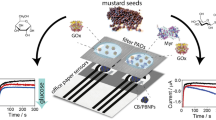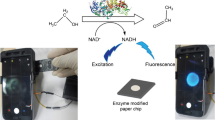Abstract
Due to their unique properties, paper-based biosensors have attracted attention as inexpensive devices for on-site analysis. To achieve fast and sensitive detection of analytes, immobilization of enzymes with high apparent activities on paper is highly desirable; however, this is challenging. Herein, we report an improved approach to attach a malathion degrading enzyme, PoOPHM9, on paper via an interlocking network of Pluronic F127 (PF127)–poly(acrylic acid)–enzyme conjugates. The addition of PF127 improved retention of enzymatic activity as the apparent kinetic constant Vmax of the immobilized enzyme increased two-fold compared with the paper prepared without PF127. The PF127–poly(acrylic acid)–PoOPHM9 papers provided rapid colorimetric detection of malathion at 0.1–50 mM. The detection was completed within 5 min using a smartphone and image analysis software. As a proof-of-concept, malathion-contaminated water, plant, and apple samples were analyzed with the papers successfully. This material is promising for on-site rapid analysis of malathion-contaminated samples.





Similar content being viewed by others
Data Availability
Not applicable.
References
Giudice, I., Coppolecchia, R., Merone, L., Porzio, E., Carusone, T., Mandrich, L., Worek, F., & Manco, G. (2015). An efficient thermostable organophosphate hydrolase and its application in pesticide decontamination. Biotechnology and Bioengineering, 113, 724–734.
EPA, Malathion. https://www.epa.gov/mosquitocontrol/malathion (accessed September 13, 2020).
Mostafalou, S., & Abdollahi, M. (2017). Pesticides: an update of human exposure and toxicity. Archives of Toxicology, 91(2), 549–599.
Cycon, M., Mrozik, A., & Piotrowska-Seget, Z. (2017). Bioaugmentation as a strategy for the remediation of pesticide-polluted soil: a review. Chemosphere, 172, 52–71.
Hernandez, A. F., Gil, F., & Lacasana, M. (2017). Toxicological interactions of pesticide mixtures: an update. Archives of Toxicology, 91(10), 3211–3223.
Sapahin, H. A., Makahleh, A., & Saad, B. (2019). Determination of organophosphorus pesticide residues in vegetables using solid phase micro-extraction coupled with gas chromatography–flame photometric detector. Arabian Journal of Chemistry, 12(8), 1934–1944.
Harshit, D., Kothari, C., & Nrupesh, P. (2017). Organophosphorus pesticides determination by novel HPLC and spectrophotometric method. Food Chemistry, 230, 448–453.
Chen, Q., & Fung, Y. (2010). Capillary electrophoresis with immobilized quantum dot fluorescence detection for rapid determination of organophosphorus pesticides in vegetables. Electrophoresis, 31(18), 3107–3114.
Mishra, R. K., Istamboulie, G., Bhand, S., & Marty, J.-L. (2012). Detoxification of organophosphate residues using phosphotriesterase and their evaluation using flow based biosensor. Analytica Chimica Acta, 745, 64–69.
Arduini, F., Cinti, S., Caratelli, V., Amendola, L., Palleschi, G., & Moscone, D. (2019). Origami multiple paper-based electrochemical biosensors for pesticide detection. Biosensors and Bioelectronics, 126, 346–354.
Qiu, Z., Shu, J., & Tang, D. (2017). Bioresponsive release system for visual fluorescence detection of carcinoembryonic antigen from mesoporous silica nanocontainers mediated optical color on quantum dot-enzyme-impregnated paper. Analytical Chemistry, 89(9), 5152–5160.
Boehle, K. E., Carrell, C. S., Caraway, J., & Henry, C. S. (2018). Paper-based enzyme competition assay for detecting falsified β-lactam antibiotics. ACS Sensors, 3(7), 1299–1307.
Böhm, A., Trosien, S., Avrutina, O., Kolmar, H., & Biesalski, M. (2018). Covalent attachment of enzymes to paper fibers for paper-based analytical devices. Frontiers in Chemistry, 6, 214.
Hossain, S. M., Luckham, R. E., McFadden, M. J., & Brennan, J. D. (2009). Reagentless bidirectional lateral flow bioactive paper sensors for detection of pesticides in beverage and food samples. Analytical Chemistry, 81(21), 9055–9064.
Hossain, S. M., Luckham, R. E., Smith, A. M., Lebert, J. M., Davies, L. M., Pelton, R. H., et al. (2009). Development of a bioactive paper sensor for detection of neurotoxins using piezoelectric inkjet printing of sol-gel-derived bioinks. Analytical Chemistry, 81(13), 5474–5483.
Credou, J., & Berthelot, T. (2014). Cellulose: from biocompatible to bioactive material. Journal of Material Chemistry B, 2(30), 4767–4788.
Sulaiman, S., Mokhtar, M. N., Naim, M. N., Baharuddin, A. S., & Sulaiman, A. (2015). A review: potential usage of cellulose nanofibers (CNF) for enzyme immobilization via covalent interactions. Applied Biochemistry and Biotechnology, 175(4), 1817–1842.
Xing, Q., Eadula, S. R., & Lvov, Y. M. (2007). Cellulose fiber−enzyme composites fabricated through layer-by-layer nanoassembly. Biomacromolecules, 8(6), 1987–1991.
Kannan, B., Jahanshahi-Anbuhi, S., Pelton, R. H., Li, Y., Filipe, C. D., & Brennan, J. D. (2015). Printed paper sensors for serum lactate dehydrogenase using pullulan-based inks to immobilize reagents. Analytical Chemistry, 87(18), 9288–9293.
Nuchtavorn, N., Leanpolchareanchai, J., Suntornsuk, L., & Macka, M. (2020). Paper-based sol-gel thin films immobilized cytochrome P450 for enzyme activity measurement. Analytica Chimica Acta, 1098, 86–93.
Zhang, L. T., Cao, X. D., Wang, L., Zhao, X. Y., Zhang, S. P., & Wang, P. (2015). Printed microwells with highly stable thin-film enzyme coatings for point-of-care multiplex bioassay of blood samples. Analyst, 140(12), 4105–4413.
Zhang, Y. F., Lyu, F. J., Ge, J., & Liu, Z. (2014). Ink-jet printing an optimal multi-enzyme system. Chemical Communications, 50(85), 12919–12922.
Riccardi, C., Mistri, D., Hart, O., Anuganti, M., Lin, Y., Kasi, R., & Kumar, C. (2016). Covalent interlocking of glucose oxidase and peroxidase in the voids of paper: enzyme-polymer “spider webs”. Chemical Communication, 52(12), 2593–2596.
Luo, X. G., Xia, J., Jiang, X. Y., Yang, M. R., & Liu, S. L. (2019). Cellulose-based strips designed based on a sensitive enzyme colorimetric assay for the low concentration of glucose detection. Analytical Chemistry, 91(24), 15461–15468.
Park, C. Y., Kim, H. R., Kim, S. K., Jeong, I. K., Pyun, J. C., & Park, S. S. (2019). Three-dimensional paper-based microfluidic analytical devices integrated with a plasma separation membrane for the detection of biomarkers in whole blood. ACS Applied Materials & Interfaces, 11(40), 36428–36434.
Liu, M. M., Lian, X., Liu, H., Guo, Z. Z., Huang, H. H., Lei, Y., Peng, H. P., Chen, W., Lin, X. H., Liu, A. L., & Xia, X. H. (2019). A colorimetric assay for sensitive detection of hydrogen peroxide and glucose in microfluidic paper-based analytical devices integrated with starch-iodide-gelatin system. Talanta, 200, 511–517.
Luo, X. J., Zhao, J., Li, C. X., Bai, Y. P., Reetz, M. T., Yu, H. L., & Xu, J. H. (2016). Combinatorial evolution of phosphotriesterase toward a robust malathion degrader by hierarchical iteration mutagenesis. Biotechnology & Bioengineering, 113(11), 2350–2357.
Bai, Y. P., Luo, X. J., Zhao, Y. L., Li, C. X., Xu, D. S., & Xu, J. H. (2017). Efficient degradation of malathion in the presence of detergents using an engineered organophosphorus hydrolase highly expressed by Pichia pastoris without methanol induction. Journal of Agricultural and Food Chemistry, 65(41), 9094–9100.
Cheng, H., Zhao, Y. L., Luo, X. J., Xu, D. S., Cao, X., Xu, J. H., Dai, Q., Zhang, X. Y., Ge, J., & Bai, Y. P. (2018). Cross-linked enzyme-polymer conjugates with excellent stability and detergent-enhanced activity for effcient organophosphate degradation. Bioresources and Bioprocessing, 5(1), 49.
Suthiwangcharoen, N., & Nagarajan, R. (2014). Enhancing enzyme stability by construction of polymer–enzyme conjugate micelles for decontamination of organophosphate agents. Biomacromolecules, 15(4), 1142–1152.
Kim, M., Gkikas, M., Huang, A., Kang, J. W., Suthiwangcharoen, N., Nagarajan, R., & Olsen, B. D. (2014). Enhanced activity and stability of organophosphorus hydrolase via interaction with an amphiphilic polymer. Chemical Communication, 50(40), 5345–5348.
Wu, X. L., Ge, J., Zhu, J. Y., Zhang, Y. F., Yong, Y., & Liu, Z. (2015). A general method for synthesizing enzyme-polymer conjugates in reverse emulsions using Pluronic as a reactive surfactant. Chemical Communication, 51(47), 9674–9677.
Funding
This work was financially sponsored by the National Key Research and Development Program of China (2016YFA0204300), the Natural Science Foundation of Shanghai (18ZR1409900), and the Key Project of the Shanghai Science and Technology Committee (18DZ1112703).
Author information
Authors and Affiliations
Contributions
X.-Y. Zhang and Y.-P. Bai designed and instructed the experiments; J.-H. Li, X.-L. Deng, and Y.-L. Zhao performed the research experiments; J.-H. Li, X.-L. Deng, Y.-L. Zhao, X.-Y. Zhang, and Y.-P. Bai analyzed the data; J.-H. Li, X.-Y. Zhang, and Y.-P. Bai wrote the manuscript. All authors read and approved the final manuscript.
Corresponding authors
Ethics declarations
Ethical Approval
Not applicable
Consent to Participate
Not applicable.
Consent to Publish
Not applicable
Competing Interests
The authors declare no competing interests.
Additional information
Publisher’s Note
Springer Nature remains neutral with regard to jurisdictional claims in published maps and institutional affiliations.
Jian-Hui Li and Xue-Lei Deng contribute equally to this work.
Supplementary Information
ESM 1
(DOCX 337 kb)
Rights and permissions
About this article
Cite this article
Li, JH., Deng, XL., Zhao, YL. et al. Paper-Based Enzymatic Colorimetric Assay for Rapid Malathion Detection. Appl Biochem Biotechnol 193, 2534–2546 (2021). https://doi.org/10.1007/s12010-021-03531-x
Received:
Accepted:
Published:
Issue Date:
DOI: https://doi.org/10.1007/s12010-021-03531-x




